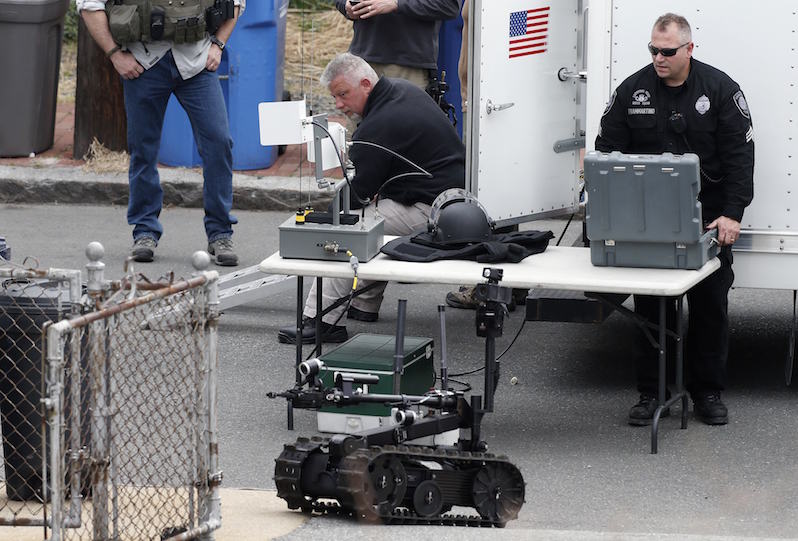Killer Robots Pose Potential Problems for Future Policing
Removing officers in the field could reduce the danger they face and the need to use force. Then again, adding a layer of distance between officers and citizens could increase the use of force. A member of the Cambridge, Mass., police bomb squad, right, deploys a robot during a search for a suspect in the Boston Marathon bombings in 2013. (Michael Dwyer / AP)
A member of the Cambridge, Mass., police bomb squad, right, deploys a robot during a search for a suspect in the Boston Marathon bombings in 2013. (Michael Dwyer / AP)
A member of the Cambridge, Mass., police bomb squad, right, deploys a robot during a search for a suspect in the Boston Marathon bombings in 2013. (Michael Dwyer / AP)
What if you got pulled over while driving and a humanoid robot walked up to your car and asked for your license and registration? That may be the future of American policing.
When the Dallas police used a “killer robot” to kill Micah Johnson after he fatally shot five police officers earlier this month, many felt it was an alarm, suggesting the takeover of police departments by lethal robots.
However, we’re not quite at that point yet.
“What happened in Dallas was the use of an explosive affixed to a remotely controlled drone, but it was called a robot because in their inventory the Dallas police were calling it a bomb robot,” Mary Wareham, who works for the arms division of Human Rights Watch and the Campaign to Stop Killer Robots, told Truthdig.
Essentially, C-4 explosive was attached to a remotely controlled [ground] drone that’s actually meant to dispose of bombs.
According to Wareham, the Dallas situation was one of the only times in American history that police have used that kind of explosive with an intent to kill. That said, while working with the Campaign to Stop Killer Robots, she has found a lot of information about drones and semiautonomous robots being able to use lethal force.
Before we have any conversation about when it’s acceptable for a robot to kill, though, we first have to examine the ethics.
“Is it right to give the ability to a machine to take a human life on the battlefield or in policing or in border control?” asked Wareham.
There is a “trend toward autonomy” in the developing world of war and police robotics, so we are probably looking at a future in which robots that have no human controller could be able to kill. Beyond whether that’s acceptable, further questions exist.
Will the robot be able to identify who is a criminal and who is an innocent bystander?
Who is accountable if the robot makes a mistake?
What if someone hacks the robot and does something terrible with it?
How will humans react to police robots?
“While robots could be a good tool, police should be aware of how visceral our reactions are to them,” Ryan Calo, assistant professor of law and a robotics expert at the University of Washington, told Truthdig. “A mistake with a car, where you run into somebody, even a mistake with a Taser, doesn’t start a national or international conversation in the way that activity with a robot does.”
Giving police robots lethal or nonlethal weapons could pose issues. For example, China currently has security robots that use Tasers. The problem, according to Calo, is that police already have a tendency to overuse weapons like Tasers, because they know such tactics make suspects less of a threat and, hopefully, won’t kill them. By adding another layer of separation—like having a person control a robot using a Taser or having an autonomous robot use one—bad things could happen.
Of course, removing officers in the field could reduce the danger they face and the need to use force — but adding another layer of distance between officers and citizens might increase the use of force.
Police robots also could be hacked and used for terrible purposes, and their use raises potential legal issues as well.
“If you have a robot that’s semiautonomous or autonomous, you’re responsible not just for its use of force but for anything it does, and you’re responsible for it constitutionally,” Calo said. “If it detains somebody, that’s a problem if it’s not justified under the Fourth Amendment, as the seizure of a person. It’s also a tort of false imprisonment, if it’s not justified. You’re responsible for all of the different things it might do.”
As we’ve seen with police use of military-style gear like the Stingray cellphone surveillance device, sometimes the police use constitutionally questionable technologies for years before there’s any pushback.
The question now isn’t whether police will start using drones and robots. It’s when. Police departments already are interested in using aerial drones for surveillance, and some have received FAA approval to use them. North Dakota passed a law last year that allows aerial drones to carry Tasers, tear gas and other nonlethal weapons.
Security robots are present across the country. One can only imagine where things go from here.
Your support matters…Independent journalism is under threat and overshadowed by heavily funded mainstream media.
You can help level the playing field. Become a member.
Your tax-deductible contribution keeps us digging beneath the headlines to give you thought-provoking, investigative reporting and analysis that unearths what's really happening- without compromise.
Give today to support our courageous, independent journalists.








You need to be a supporter to comment.
There are currently no responses to this article.
Be the first to respond.